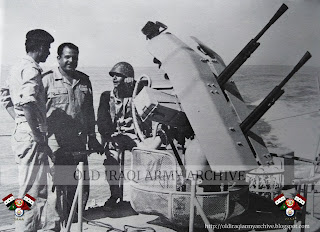The Origins of the Iraqi Army
On 6 January 1921, the Headquarters of the
Ministry of Defense was established. Initially, the Army was formed of
volunteers between 18 and 40 years old with serving terms ranging from two
years for Infantry to three years for the other arms, consisting mainly in
those days of Cavalry, Packed Artillery and Animal Transport. On the 28 July,
1921, the First Infantry Regiment was formed and placed under Iraqi Officers that
had service records in the Turkish Army. The Army was organized on a Regiment basis at the beginning. This was changed later and the Infantry Brigade was
considered to be the standard fighting formation. It was designed and equipped
to operate on various types of Iraqi terrain which varied from mountains in the
north to deserts and marshes in the south. In mid-1936, though, the Army was reorganized on a Divisional basis, with the First
Infantry Division (1ID) and the Second Infantry Division (2ID) being created on
the 15 April 1936.
The period of the Second World War
was critical for the Iraqi Army, as a number of changes took place and units
and formations were reduced in size and equipment. In 1940, the Iraqi Army
featured already four Infantry Divisions, with various Cavalry Battalions and
the necessary supporting arms and services. In 1941, the Iraqi Army had its
best units stationed in Baghdad to protect the capital against any internal or
external threats. There, the 1ID and 3ID were supported by an Independent
Mechanized Brigade, which comprised a light tank company, an armored car company, two regiments
of mechanized infantry transported in trucks and a mechanized machine-gun
company.
 |
| An Iraqi infantry regiment during a parade in 1941. (OIAA archive) |
After the Second World War, the Army was
reorganized on the lines followed by various other modem armies. Lessons of the
Second World War were taken into consideration and the improvement in economic
conditions in Iraq had a great effect in this matter. By then, money was
available to supply the Army with modem arms, raise the conditions of officers
and other ranks and to build new camps and barracks in order to raise up the
living conditions and maintain various other essential requirements.
After the 1958 Revolution, the Iraqi Army decided to transform the 3ID
into an armored unit. Also known as
the 'Saladin Forces,' this division, headquartered at Habbaniyah, consisted of
the 6th Armored Brigade (6AB), the 10AB (commanded by the
late Col. Hammad Shihab al Tikriti) and the 11th Mechanized Brigade (11MB) (an old brigade that had
taken part in the fight against the British in 1941 and which would end up, years later, being disbanded and replaced by a newly-created 8MB).
 |
| An Iraqi Centurion Mk3 tank from the 3rd Armored Division in late 1957. (OIAA archive) |
 |
| Eight 203-mm American M-115 Howitzers from the 114th Battalion displayed during the Army Day parade in Baghdad on 6 January 1957. (OIAA archive) |
Being ordered in 1958, the Iraqi Army received their
first lot of 250 Soviet T-54 tanks in 1959, which were allocated to the 6th Armored
Brigade of the 3rd Armored Division (6AB/3AD) and the 10AB/3AD. An important leap forward as the Soviet armor was going to play an important role in the future of this army.
 |
| A group of T-54 tanks from the 3rd Armored Division also known as the "Saladin Forces." (OIAA archive) |
By 1961, the Iraqi Army was made up of several divisions
organized on a modern basis supplied with up-to-date equipment. Requirements for
operations in the mountains were met by organizing first-line transport on an
animal basis in certain divisions. Apart from the armored and infantry
division, the Iraqi Army featured also various supporting arms at Corps and
Army level, including Heavy Artillery (including rockets), paratroopers, a naval base
and several small vessels operating in the Gulf and Shatt Al Arab.
 |
| An Iraqi paratrooper during training courses. (OIAA archive) |



Comments
Post a Comment